How to Build Hugelkultur Raised Garden Beds
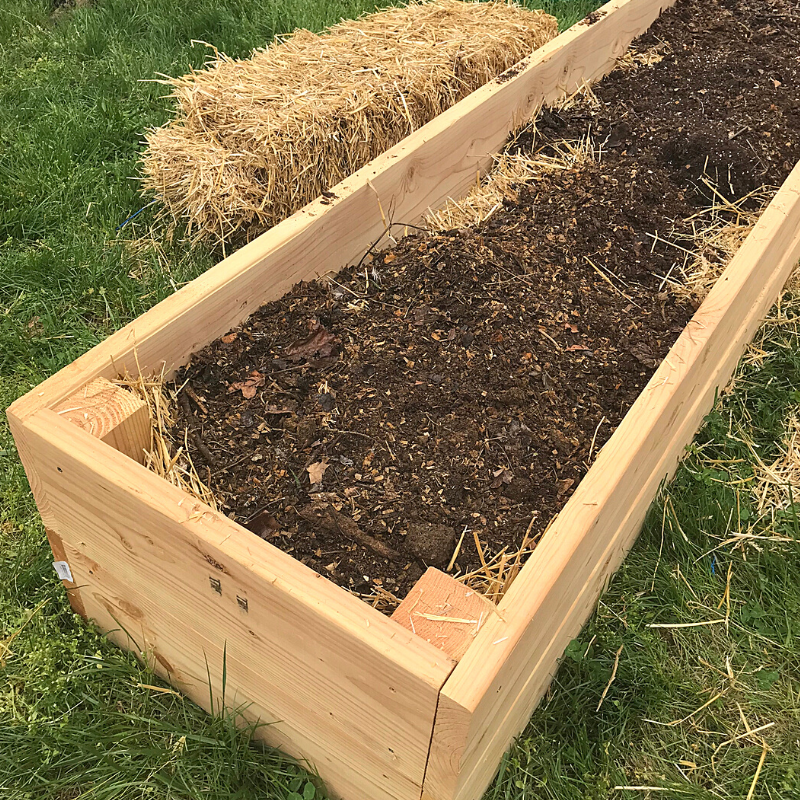
Plan your best garden with simple, step-by-step instructions!
This post may contain affiliate links, which means I make a small commission at no extra cost to you.
See my full disclosure here.
It all started with a permaculture book checked out from the library last year. I had no idea about Hugelkultur raised garden beds until then, but once I learned the concept it made perfect sense!
Why didn’t I think of this before?
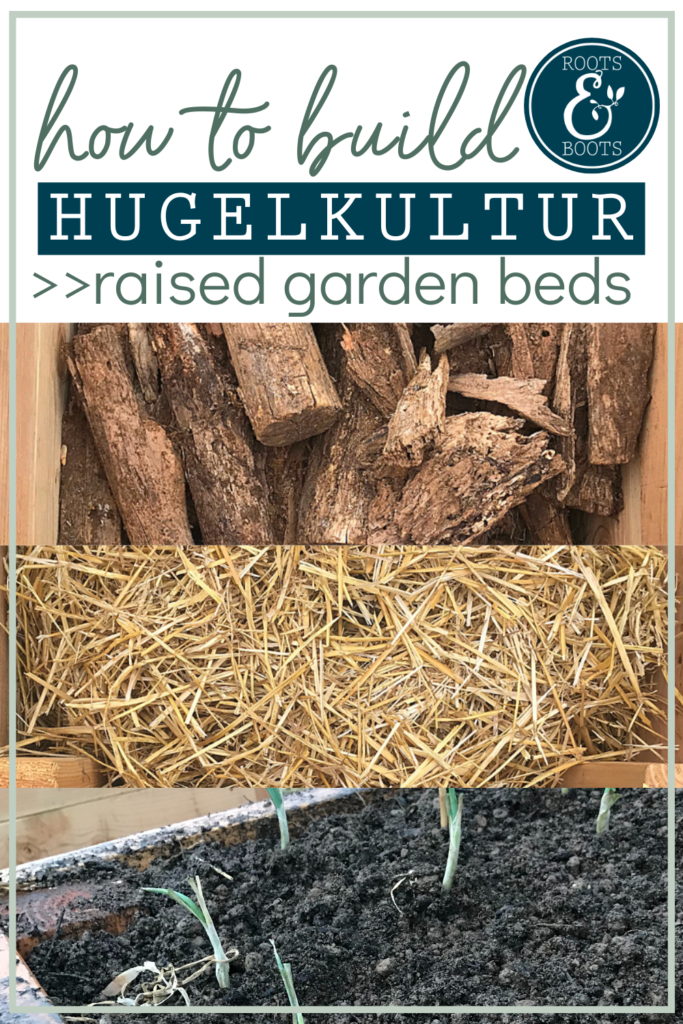
Hugelkultur is a German word that means “hill culture”. Hugel beds start with a base of logs, branches, and twigs. Then layers of organic materials are added on top, such as grass clippings, hay, straw, leaves, manure, compost, and finally top soil.
Hugelkultur raised garden beds mimic natural woodland composting. A tree falls in the forest and decays on the ground. Over time, organic materials fall or grow on top of the rotting wood. As the wood rots, it retains water and delivers nutrients to the soil and eventually breaks down completely into wonderfully rich soil.
Doesn’t this sound like the perfect method for organic gardening? I’m super excited to experiment with hugelkultur raised garden beds on our new farm.
Update: after one full year with our hugel beds, I’m sharing an update! Read it here: 3 Important Tips for Hugelkultur Raised Beds.
6 Benefits of Hugelkultur Raised Garden Beds
1. Water retention
The bottom layer of wood acts like a sponge, drinking up rainwater and slowing making it available to plant roots. I’ve heard that hugelkultur raised garden beds do require some watering during the first year as they get started, but should be largely self sufficient from then on.
2. Good drainage
This is true of raised beds in general, but especially of hulgelkultur raised garden beds. The stacked layers of organic materials plus the wood at the bottom make hugel beds resistant to flooding.
3. Soil improvement
The organic ingredients of a Hugel bed combine to create a rich, nutrient dense soil.
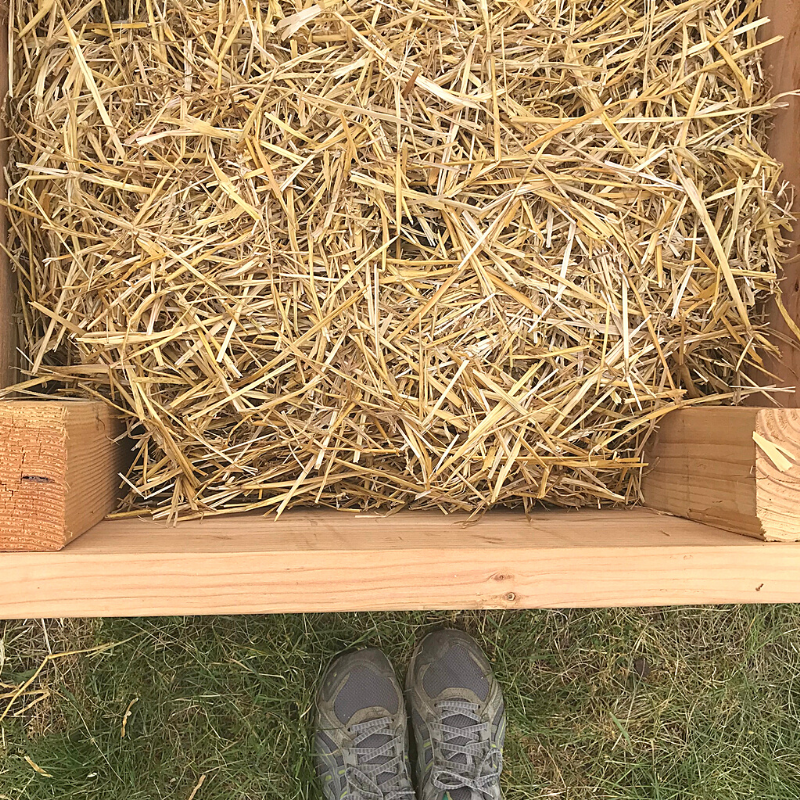
4. Soil temperature
Similar to a compost pile, the decaying biomass inside hugelkultur raised garden beds heats up and warms the soil. This can actually extend the growing season by allowing the gardener to plant warm weather plants a bit earlier in the spring and keep them growing a bit longer in the fall.
5. Maximized growing space
True hugel beds mounded on the ground or in trenches can be quite tall. Plants can grow up one side and down the other, which yields much more growing space than a traditional flat raised garden bed.
6. Recycled tree waste
Organic gardeners love to compost any organic biomass they can get their hands on. But logs and branches often pose a challenge because they can take so long to break down in a compost pile. Incorporating fallen trees and branches on your property (and maybe from the neighbors, too!) into hugelkultur raised garden beds is an efficient way to compost all that valuable wood.
3 Ways to Build Hugelkultur Raised Garden Beds
1. On the ground
Advantage: easy! No digging required.
- Simply spread a layer of cardboard or very thick newspaper on the ground. I’ve heard that if you layer them high enough, hugel beds can even be created on top of concrete!
- Pile wood, logs, branches, wood chips on the cardboard.
- Add layers of organic materials: grass clippings, leaves, hay, straw, manure, compost.
- Finish with top soil.
2. In ditches or trenches
Advantage: produces a lower hugel bed that may blend more seamlessly with existing landscapes.
- Dig a trench as deep as you like.
- Pile wood, logs, branches, wood chips in the trench.
- Lay the removed sod upside down on top of the wood.
- Add layers of organic materials: grass clippings, leaves, hay, straw, manure, compost.
- Finish with top soil.
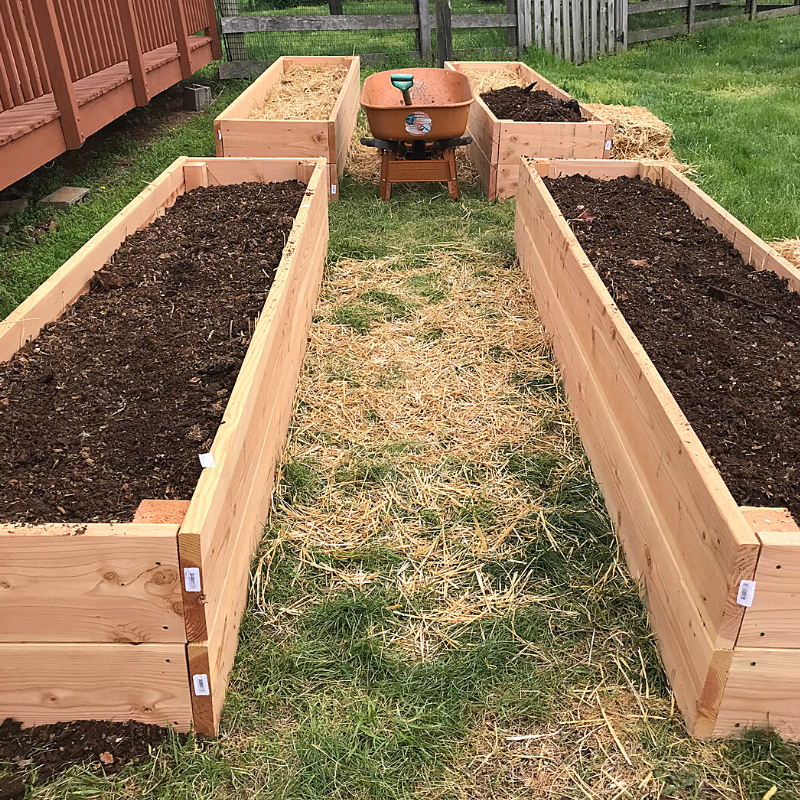
3. In containers
Advantage: great for small spaces, city dwellers, and raised beds.
We used this method in our newly constructed wooden raised beds.
- Depending on the size of your container, start with a base of logs, twigs, or wood chips.
- Add layers of organic materials: grass clippings, leaves, hay, straw, manure, compost.
- Finish with top soil.
Important Tips for Creating Hugelkultur Raised Garden Beds
1. Depth – The combined layers of organic materials on top of the wood should be about 12″ deep.
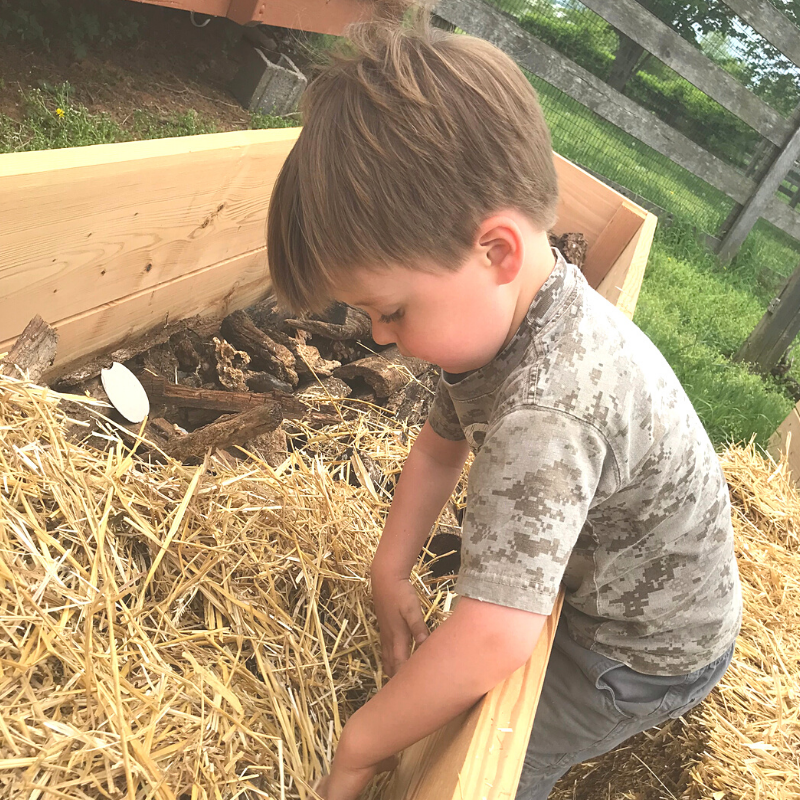
2. Prevent diggers – Lay a sheet of metal hardware cloth on top of the cardboard before adding wood and organic materials to deter voles, mice, and other digging garden pests.
3. Plan ahead – If possible, consider preparing your hugel beds in the fall and allowing them to rest over the winter. Add a fresh layer of compost on top prior to planting in the spring.
4. Consider nitrogen – During the first year of a hugel bed, the decaying wood will rob nitrogen from the soil. The fresher the wood, the more nitrogen it will require as it breaks down. Consider adding nitrogen sources via the methods listed below. If your wood layer is already rotting, you may not need additional nitrogen.
How to Add Nitrogen to Hugelkultur Raised Garden Beds
1. Human urine
Yes, really. This method works especially well if there are menfolk around. They can pee directly into the soil, or pee in buckets and then add to the soil.
2. Green layer
Use grass clippings or sod turned upside down. Place this green layer directly on top of the wood to help it break down.
3. Peas and legumes
Planting peas or other legumes in the first year will add nitrogen to the soil.
4. Cover crops
If you prepare a hugel bed in the fall and let it rest for the winter, you could simultaneously grow a cover crop to add nitrogen to the soil. More details on cover crops here.
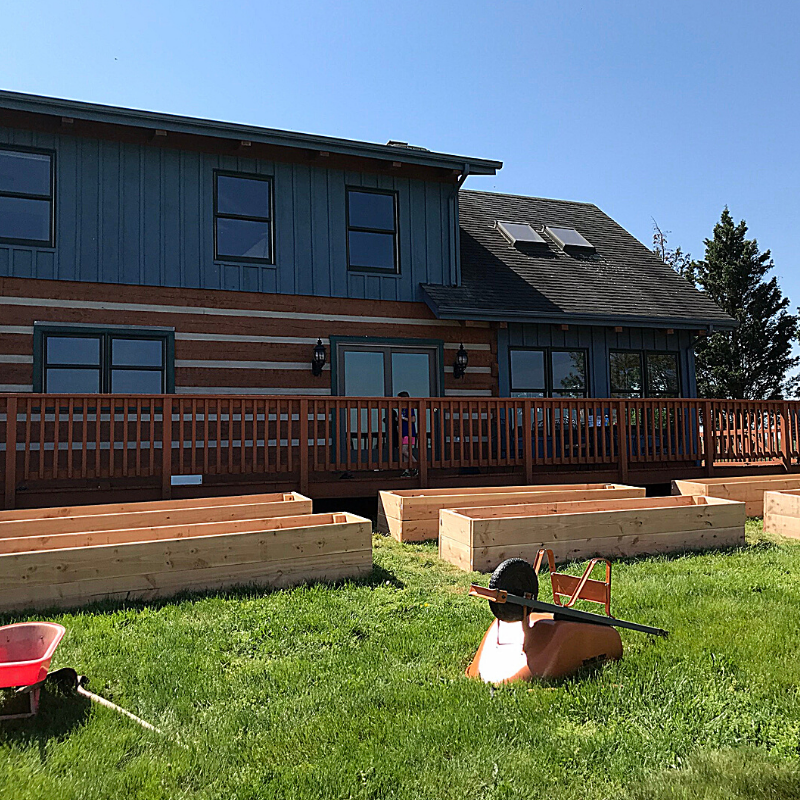
Our Hugelkultur Raised Garden Beds
Be sure to read my one-year update here: 3 Important Tips for Hugelkultur Raised Beds.
Our hugelkultur raised garden beds were the result of simple supply and demand.
We had already decided to build raised wooden garden beds, for a number of reasons. It can get pretty expensive to fill raised garden beds with good stuff, so we put on our thinking caps.
- The demand: to create new gardens from scratch at our new farm, and to do it quickly.
- The supply: a pile of rotting fire wood and beautiful compost.
Bingo! Hugelkultur was the perfect solution.
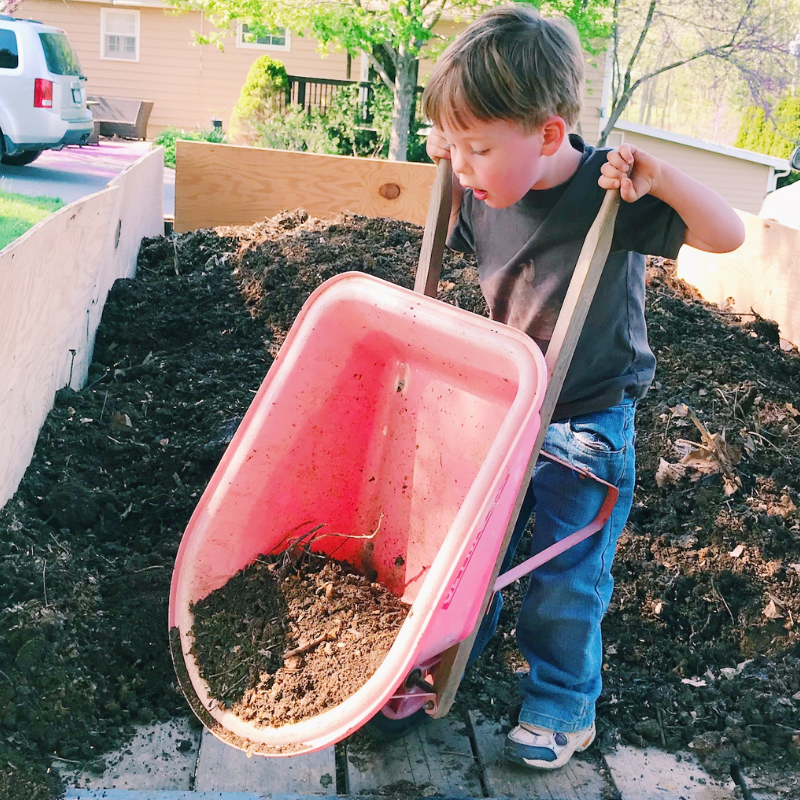
One small problem: the logs and compost were at our former house.
Our solution: haul it all to the new farm! We now own a tractor, but at the time our only option was to load it all by hand and wheelbarrow. Man, gardening is good exercise!
What We Did
- We started with a layer of chicken wire, mainly because we already had it on hand and we were in a hurry. Hardware cloth would have been a more bulletproof option, but I’m crossing my fingers that the chicken wire is enough to keep out the diggers.
- Next we added a thick layer of newspaper and rolls of newsprint, again, because it was on hand. After we unpack all our boxes, we’ll have plenty of cardboard available! I plan to save it all for future hugelkultur projects.
- Then came the rotting logs.

- Next we added a layer of straw.

- Compost came next.
- And finally, we topped it all with a layer of top soil.
- Our beds were ready for planting! Onions went in first, because the live slips had just arrived from Johnny’s Seeds. That’s why we were in such a hurry!

- Since then, I’ve completely filled the boxes with seeds and transplants.
I’m eager to watch everything grow in our new hugelkultur raised garden beds, and to continue experimenting with additional hugel beds. Live berry bushes will be arriving in the mail soon, and I’d love to plant those in hugel beds right in the ground.
Stay tuned as our adventures in hugelkultur continue…
Have you tried hugel beds? What do you think of this method of gardening?
More ways to use hugelkultur in your garden:
- 3 Important Tips for Hugelkultur Raised Beds
- How to Create Trenched Hugelkultur Beds
- 3 Steps to Create Hugelkultur Beds on the Ground
More about seeds and gardening:
- 6 Tips for Gardening in Heavy Clay Soil
- DIY Wooden Raised Garden Beds
- 5 Secrets for Growing Better Carrots
- How to Start Seeds Indoors
- Simple DIY seed-starting shelves
Want More Help?
Hügelkultur Ebook - 18 pages
Tried and true methods for fast results: build your soil and grow better veggies.
You might also like...
28 responses to “How to Build Hugelkultur Raised Garden Beds”
-
Hi Kathleen,
I love hearing about your new adventures, you are so full of enthusiasm and your little boy is gorgeous.
Those beds look fantastic!!!
Looking forward to Health Hints no. 92 and seeing how your seedlings etc. are coming along 🙂
-
I have had hugelkulturs for several years now and LOVE THEM! We live where the soil is clay and many of my previous gardens either drown when it rained or died because their poor roots couldn’t dig into the clay. We dug down about a foot, added rotten trees and logs, covered up with composted horse manure and then added SOME of the clay back on top, but really the manure would have been enough. I do find that I need to water them because the “wicking up” from the logs is not usually enough- although the plants near the bottom do extremely well. Every spring I mulch with grass clippings so that it continues to receive nitrogen, plus weed control.
-
Awesome, Carrie! I’m so glad to hear about your hugel beds!
-
Thanks, Linda! 🙂
-
-
Lots of good info. Thanks for sharing.
-
Sure thing!
-
-
Works great in the ground- but won’t it also speed up the decay of your raised bed lumber by a lot?
Thanks,
M -
Nice info – thank you. I’m a novice gardener that recently cleared a hedge row. I was wondering how I could put the ‘waste’ back to work! And thought that it would be good to use as a base in a raised garden. Your info confirmed it! Thanks again.
Quite a bit of the ‘waste’ is sumac. What are your thoughts about using this in the bottom? I’m wondering if the poisonous oils will adversely effect the plants and us when we eat the fruits of our labor!
-
Hi! How did your raised beds do last year? I would like to make raised beds and would like to know what the thickness of the layer of topsoil is. Your beds are 12 inches tall, how was that height divided between the different layers? Wood chips are ? inches, straw ? inches, compost ? inches and topsoil ? inches. Is it an equal division of 3″ each?
-
Hi Tamie, That’s a great question. I’m about to publish an update on our hugel beds and what I’ve learned after one full year, but for now I can tell you that your top layer of soil should at LEAST match, or even exceed, the depth of the wood base.
-
Hmmm, Scott, I’m not sure about sumac. I’ve read a number of hugel-how-to’s and no one mentions avoiding sumac. Some people even say you can use any type of wood as long as you add extra sources of nitrogen for those that take longer to decompose, such as cedar and fir/pine. This source recommends avoiding most or all cedars (cypress, redwood, sequoia)
camphor wood
black locust
black cherry
eucalyptus
tree of heaven (Ailanthus altissima)
black walnut (Juglans nigra)
California pepper tree (Peruvian and Brasilian)
Siberian ElmHope that helps!
-
-
Hi Kathleen,
Thanks for the article. I am thinking about doing something similar, but maybe just starting with wood chips to speed the breakdown.
YOu had noted “Planting potatoes or other legumes in the first year will add nitrogen to the soil.” Potatoes are not actually legumes and I do not believe that they will contribute nitrogen.
Brian
-
Hi Brian, You are correct: I’m embarrassed to realize that I meant “peas” and not potatoes! I’ve edited my post. Although I have read that potatoes can make a good first year crop for a brand new hugel bed.
-
-
Can i put a later if plastic down first than the wood, hay etc???
-
I can’t think of any good reasons to use plastic in a hugel bed. May I ask what purpose the plastic would serve?
-
-
Hi, great info!!
So, for wood, branches, … can I also use spruce branches/logs?
Thanks,
Silvina -
Hi! I found your post from a Beginner Gardener group on Facebook 🙂 I love your raised beds – did you build them yourself, and what approximate dimensions are they? Have those dimensions worked well for you? Thanks! ~Elise, Colorado
-
Yep, we built them ourselves and I love the dimensions. Tutorial coming soon! 🙂 UPDATE: DIY Wooden Raised Garden Beds.
-
-
Hello. Is there any concerns about termites that may be in the rotting wood at the bottom of the garden?
-
This is a great question, and the answer may depend on who you ask. Yes, rotting wood can attract termites. Is this a bad thing? Probably not. Termites actually help to break down the wood and build the microbiology of the soil, which is a good thing, similar to the work of earthworms. Should you pile rotting wood against your house? Probably not a good idea. But rotting wood placed somewhere away from the house should not be a concern.
-
-
I would also like to know the details on the raised bed boxes. Thank you!
-
More details here. 🙂
-
-
Hello,
I’m in New York State, a master gardener (ha!) with Cornell Cooperative Extension Services, which for our Chenango County is in Norwich, NY.I’ve a job to gather data for a presentation @ our next August meeting to answer an asked question: What are the growings coming out of the bottom of the 1-year old pile? Are these likely the wood pieces used sprouting? Would it likely be what’s been in the soil? I know, they seem to be obvious yet I thought since I may be set up on a goose chase nonetheless give it a go and ask. Not to worry . . . I ask almost anything I don’t know about . . . and this I don’t. . . for sure. Perhaps you do. I’m asking in this possibility you will.
I love permaculture concepts and practices . . . have Dave Jacke’s Edible Forest Garden, & Mollison’s Permaculture: A Designer’s Manual. And others. (semi-credentials)
Blessings.
-
[…] of all! By the end of the week we had completed the beds, filled them with wood (as per the Hugelkultur method), and topped them with straw. We still have to move the dirt on […]
-
We are starting on our first hugelkutur raised bed. I’ve seen in a lot of videos that the logs on the base are oriented vertically so that they are better suited to retain water that drains into the bed.
Do you know whether that makes a difference at all, or is it just as good to throw the logs in there every which way?
-
Honestly, it’s just as good to get the wood under there any way it works best.
-
-
excellent, been using above ground beds for several years and to keep out the diggers I put in galvanized 1/2″ wire screen on the botton then the other soil, adament etc and so far moles, voles, golphers are staying out.
-
good to hear!
-








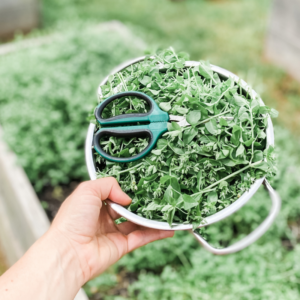
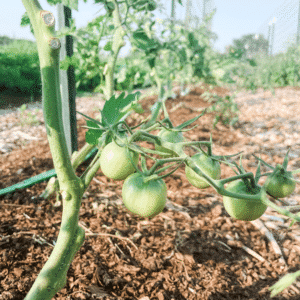
Leave a Comment